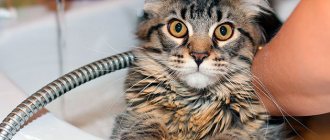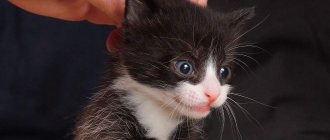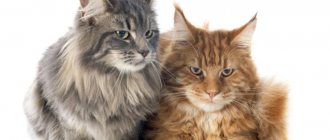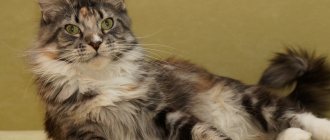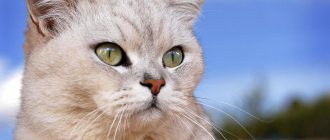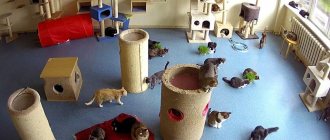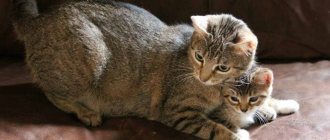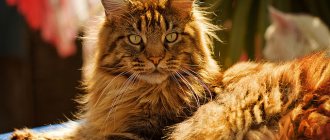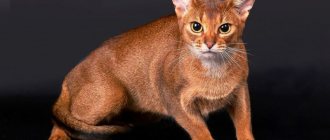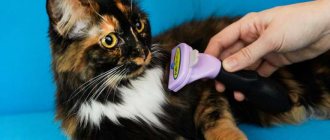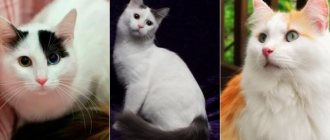8217Administration
1
Maine Coon cats, bred in the American state of Maine, are among the most beloved pets among Russian breeders. You can recognize them by their powerful build, fluffy tail and large ears with tassels.
Caring for the Maine Coon's coat deserves special attention, as it is thick. With proper care, which includes regular brushing, a balanced diet and the absence of stressful situations, these animals will delight in the beauty of their appearance.
Maine Coon Care
For Maine Coons to have a particularly attractive appearance, they will need to be carefully groomed. The owner of a representative of this breed needs to know that special attention should be paid to the condition of the cat’s ears, eyes and face, its fur and claws.
Ears
They need to be inspected regularly. The cat must be accustomed to this procedure during the game. If the kitten likes it, then cleaning the ears in the future will not be difficult. Maine Coon ears in a healthy state are pink inside, without wax. It is better to remove its accumulations with cotton pads rather than cotton swabs, so as not to cause injury. Moisten the tip of the disc with special drops for the ears of kittens or adult cats.
They can be purchased at veterinary stores or pharmacies. The drops cleanse the ears not only of wax, but also of ear mites. After cleaning, you can drop a couple of drops into your ears or powder the entrance to the auricle with a special powder. This will prevent ear mites from getting inside.
Eyes
Mucus and dirt sometimes accumulate in the corners of the eyes, even in healthy pets. You can clean the eyes with a cotton swab, which should be moistened with water or weakly brewed tea. Attention! You should absolutely not use chamomile infusion for cleansing - it provokes hair loss around the eyes.
Muzzle
A feature of the Maine Coon breed is its minimal susceptibility to plaque. Particular attention should be paid to the baby's face (at three to five months) when his baby teeth are growing. During this period, it is useful to examine the oral cavity at least a couple of times a week.
If teeth grow with a defect, you must contact a veterinary clinic. The doctor will take the necessary measures for treatment. In order for the bite to develop correctly and meet the norm, it is useful for the kitten to be given dry food and small rubber toys. It is advisable to brush your pet's teeth every day with a soft brush and special cat toothpaste.
Claws
Strongly overgrown claws cause discomfort for the cat. They must be periodically trimmed with special round scissors that are safe for the vessels located in the claws. A claw without pigment spots must be trimmed by placing it under the light at an angle. But the pigmented claw will have to be trimmed, cutting off only the edges.
The claws on the front legs are shorter than on the hind legs. Maine Coons like to sharpen their claws often. Therefore, it is useful to install a scratching post or a special pad.
Choosing a kitten, care, education
When choosing a raccoon kitten, the main thing is to take your time. To prevent the animal from causing disappointment in the future, it is first worth visiting several exhibitions and studying the peculiarities of raising and caring for the breed.
Choice
There are 2 types of giant cats: European (extreme) and American (classic) coons. “Europeans” are big-boned, large, squat animals.
A characteristic feature of the “Americans” is large ears with long tufts.
Upbringing
It is worth teaching a Maine Coon to order from the moment he gets into the house. Giant cats are easy to socialize. They are not prone to stubbornness, do not have a grudge, and they do not have hysterical attacks.
A characteristic feature of “Americans” is large ears with long tufts.
It is easy to negotiate with a Maine Coon using the rules of prohibition and rewards. There is no point in physically influencing kittens. The only thing that can be used as punishment is a spray bottle of warm water.
With its help, you can easily stop a naughty pet from scratching furniture or climbing onto a cabinet or kitchen table.
Toilet training
When a small pet appears in the house, it is important to monitor its behavior. If the kitten is looking for a secluded place, shows restlessness and constantly meows, it means that he wants to go to the toilet.
At this point, the pet must be placed in the prepared tray for a few minutes. In order for the animal to adapt faster, this procedure is repeated several times during the day.
At first, you should not allow the kitten to walk around the entire apartment. Its space is limited to the room where the tray is installed and another room.
If the kitten nevertheless “organized” the toilet in an unauthorized place, the puddle is blotted with a napkin, which is placed in a tray. The familiar smell will help the kitten to accurately find the toilet the next time.
Be sure to read:
What to feed a Maine Coon kitten: recommendations, diet from a month to a year, what not to give
How to comb
Maine Coons have long coats that require special care. For this procedure you will need one or two combs with sparse and fine teeth. The tips of the teeth should be blunt and not sharp. It is also advisable to have a comb with long, sparse and rounded teeth, as well as a massage brush. You can use it to brush your cat before shows. The massage brush should also be used during the shedding period.
First, combing is carried out with a comb with sparse teeth, then with fine teeth. You need to comb in the direction of the fur. For convenience, you can divide the wool into partings. It is not recommended to scratch the neck area, hind legs and tail with a fine comb, as the hair there takes a long time to recover.
Long, thick fur sometimes develops tangles. They usually cluster on the chest, belly, hind legs, behind the ears and in the lower neck area. The tangles cause anxiety for the cat. They tighten the skin when wool is wrapped around the tangle. It must be divided into several parts and combed out. If this cannot be done, then you can carefully cut it off with nail scissors or tweezers. To do this, pull the tangle towards you and cut off the hairs directly under it.
It is better to brush your Maine Coon no more than four to five days. Brushing prevents severe hair loss and massages the hair. It is advisable to train your pet from an early age.
Causes and signs of hair problems
An unbalanced diet of an animal leads to a deficiency of nutrients in its body.
Sometimes owners note that despite regular bathing and proper care, the coat of a kitten or adult pet peels off at a rapid pace. The animal sheds constantly, looks unhealthy and emaciated. There are many reasons for this condition, the main ones are:
- Hormonal imbalance. Often, problems with the condition of the coat arise during puberty, estrus, pregnancy, feeding kittens, due to frequent matings of the cat.
- Unbalanced diet. If there is a lack of vitamins, elements and substances necessary for the body in the Maine Coon’s diet, the coat is the first to suffer. Therefore, if the owner notices that the pet’s tail is peeling, you should contact the veterinarian and together with him create the correct menu or select a suitable factory-made food.
- Incorrect care. When using low-quality, cheap shampoos, using slicker brushes, as well as infrequent or too frequent washing, the cat's fur begins to peel off rapidly.
- Diseases. If a cat has a history of pathologies such as allergies, gastrointestinal disorders, systemic diseases, the likelihood that the coat will also suffer increases.
In addition to problems with the coat, the following symptoms indicate that the Maine Coon is not in good health:
If your pet also sleeps a lot, then he clearly has health problems.
- redness and itching of the skin;
- indigestion;
- problems related to the intestines;
- respiratory dysfunction;
- increased body temperature;
- formation of crusts, scales, bubbles, seals on the body;
- swelling of the mucous membrane;
- lethargy, drowsiness, apathy;
- loss of appetite and weight loss.
How to get rid of it?
If Maine Coon shedding continues for a long time and the symptoms make it obvious that the cat has health problems, you should not self-medicate. It is urgent to show your pet to a veterinarian, who, after an initial examination and diagnosis, will determine what to do next. If problems with the condition of the coat are associated with poor nutrition, the doctor will help you adjust your diet and advise which vitamins and active supplements to use to improve the situation.
When diagnostic results confirm the presence of any internal diseases, a comprehensive treatment regimen is prescribed, which includes drugs from various groups and auxiliary treatment methods. If your cat suffers from allergies, you need to find out the source of the problem and try to eliminate it. Sometimes it is enough to change the food or hygiene product, and the animal’s well-being will improve, and the fur will again shine with beauty and health. Some veterinarians advise castrating Maine Coons, of course, if the owner does not plan to breed offspring. In this case, castration will help avoid the development of hormonal dysfunction, from which the cat’s coat also suffers greatly.
Water treatments for Maine Coon
The difference between Maine Coons and other breeds is that these cats are not afraid of water. The reason is probably that once upon a time their ancestors were often taken by sailors on voyages. These cats have developed a habit of drinking water.
It is rare that representatives of this breed do not like to swim. Most people treat water quite calmly. To avoid problems with bathing, it is useful to accustom a kitten to water procedures from an early age. You can start bathing your pet only four hours after eating. It is important that the cat does not get scared and does not catch a cold in a draft; it is better to bathe with the door closed.
Basic rules for bathing Maine Coons:
- First, the cat needs to be combed and examined to see if there are any wounds. If necessary, trim the claws. You need to check the ears and clean them if necessary;
- It is better to bathe your pet in a small bathtub for newborns, in a basin or sink. The water should be warm, about 38 degrees;
- You need to put a flannel diaper on the bottom so that the cat’s paws don’t scratch the bottom or slip;
- When bathing, hold the cat well by the withers (this is how mother cats hold their kittens);
- With your free hand, wet a large sponge and add a small amount of special cat shampoo. Use a foam sponge to rub it all over the coat so that the shampoo penetrates deep into the skin. Attention! It is strictly forbidden to rub the sponge from side to side, so as not to tangle the fur and turn it into a wet pile;
- You must soap your face carefully so that the foam does not get into your eyes or get into your nose and ears;
- A washed cat should be rinsed, washing off the foam with a light shower. When rinsing it, you need to help wash off the foam with your hand. The fur should “creak” under your hand. If the coat is poorly washed, the residue of unrinsed shampoo can cause irritation on the skin. Also, the cat will look untidy;
- To make the fur shiny later, you can use a cat conditioner, which is easily washed off a few minutes after application;
- It is strictly forbidden to use shampoos intended for humans. Detergents for pets are available in pet stores and veterinary pharmacies;
- The cat will tolerate bathing much more calmly if you speak to him kindly, soothingly, and praise him - what a great guy he is. The pet will bear the stress of washing more easily and calmly;
- After moving the cat to a comfortable dry place or draining the water from the bath, the pet’s fur should be blotted with a towel, either terry or paper. This is necessary to remove excess moisture. Afterwards you can start drying it. If the cat is not afraid of a hair dryer, you can choose this drying method. If he is afraid, you can dry the fur thoroughly with paper towels to remove any remaining moisture.
During the entire procedure of bathing and drying the cat, there should be no drafts so that the pet does not catch a cold.
Bathing a Maine Coon cat. Where to begin?
A dried-out cat must be combed according to certain rules:
- chest, throat, ears, cheeks: comb from bottom to top;
- sides from the tummy to the top of the back;
- belly from the middle, in both directions;
- The paws can simply be tousled.
It is best to bathe your pet once a month. Frequent water procedures are not beneficial for cats.
Take note
Which combs to choose?
Basic option: a comb with teeth on one side that are longer and less frequent, and on the other side shorter and more frequent. The teeth of the comb should be rounded at the ends so as not to injure the skin. A brush made of natural bristles is suitable for the tail, belly, collar and panties. A slicker brush is most often used when drying the tail with a hairdryer after bathing, but the tail is combed out very carefully.
Can I use a furminator?
The Furminator can be useful only during the period of active molting, if the Maine Coon does not participate in exhibitions. With its help, you can comb the back and sides, but do not get carried away, otherwise the coon will lose all its rich undercoat, and its coat will no longer be thick. Under no circumstances should you comb the tail with a furminator.
Why do you need to degrease wool?
The fur of adult Maine Coons, and even more so of coons participating in the breeding program of the nursery, becomes greasy. Therefore, it should be degreased, otherwise the Maine Coon, even after bathing, will look dirty. In addition, the covering coat of Maine Coons has a water-repellent effect, so in order for it to get wet, it must be degreased. When degreasing, a special paste (Jerob, GOOP) is applied to dry wool, paying special attention to the panties, the area behind the ears, the base of the tail and the back.
How to “extend” brushes on the ears?
Some people advise plucking sparse and short tufts on the ears so that thick and long tufts can then grow. In fact, they will not become longer and thicker, because these are signs that are laid down at the genetic level. And if the brushes are not very satisfactory, then there is no need to torment the Maine Coon with useless trimming.
Nutrition - what and how to feed?
Proper feeding of Maine Coons is an important part of a cat’s healthy life. It is important to choose the right food and water containers for your pet.
It is necessary to take into account the fact that in the wild, the ancestors of cats, before drinking, try to clear the surface of the water from debris, fallen leaves, and twigs. At the same time, water is sprayed in different directions. Pets have retained this reflex. The Maine Coon may even knock over a bowl of water or move it along the floor. Therefore, the drinking container should be moderately heavy or fixed to the floor so that it does not move and cannot tip over.
The food bowl should be kept away from the water container. Otherwise, splashes that get into the food bowl can ruin the food. If the cat stays at home without its owners for a long time, it is better to purchase a water bottle. Water should always be fresh and clean.
Feeding Maine Coons has its own rules:
- You only need to feed your cat dry food of premium quality. It contains the necessary vitamins and various nutritional supplements that are important for the health and normal development of Maine Coons. Can be combined with canned food;
- if you feed with natural food, then the basis of the diet (at least 80%) should be meat and dairy products, vegetables and grains;
- If the cat's diet consists exclusively of natural products, it is necessary to regularly give vitamins;
- with a mixed diet, dry food should be the basis, and natural food should be additional.
What natural products can you feed your Maine Coon:
- meat: poultry, beef (raw and cooked), rabbit, lean lamb, chicken livers and hearts.
- vegetables: carrots, beets, cabbage, cucumbers, zucchini, pumpkin, tomatoes;
- hard cheese;
- eggs: yolk once or twice a week, boiled or raw;
- boiled sea fish, seaweed and other seafood;
- cereals, bran;
- fermented milk products: cottage cheese, yogurt, kefir, fermented baked milk (milk can only be given to kittens under 3 months of age);
- cereals: three to four times a week as an addition to boiled meat;
- sprouted grains: wheat and oats.
Important!
It is prohibited to add salt, sugar, or spices to cat food. It is strictly forbidden to give your pet beef and chicken bones, fatty pork, duck, goose, smoked meat products, sausages, sugar, potatoes, legumes, and chocolate.
Cats need to eat fresh greens periodically. To prevent your pet from being drawn to dusty, dirty grass during a walk, you need to sow grass seeds (wheat, oats) in a low, wide container (box) at home and allow the cat to eat the young sprouts.
If a cat is allergic to any of the food or products, the allergen should be removed from the diet.
Cat food should not be hot or cold. It should be at room temperature. Kittens need to grind their food. The kitten should eat at least 5 times a day. This principle must be maintained for up to 2 months. From six months onwards, the frequency of feedings is reduced to three times a day, and eight-month-old cats should be switched to two meals a day.
How to take care of the health of your Maine Coon cat
The health of the North American Longhair cat is based on a healthy, balanced diet, an active lifestyle, and sufficient space for rest and play.
Do not forget about communication between the cat and the owner; Maine Coons need care, affection, and attention from humans.
Prevention of diseases and timing of vaccinations at the veterinarian
Maine Coons have a genetic predisposition to a number of diseases, so it is recommended to carefully check the breeder and be interested in reviews from other buyers.
Genetic diseases are the result of poor quality, thoughtless mating of purebred cats, carried out without specialized selection of the best representatives of the species.
Maine Coons are predisposed to the following diseases:
- diseases of the musculoskeletal system (arthritis, joint inflammation, hip dysplasia, spinal muscle atrophy);
- skin diseases (abscesses, the occurrence of suppurating and inflammatory processes on the skin, eczema);
- kidney problems, urinary tract diseases (formation of cysts on the kidneys, formation of stones).
Pet health - maintenance and care
Caring for a pet primarily involves paying attention to its health. To prevent your cat from getting sick and live a full life, it is necessary to take preventive measures. A domestic cat can catch the disease not only on a walk, but also at home. Infection or parasites may be brought in by shoes.
Prevention:
- once a year you need to be vaccinated against rabies, panleukopenia, calcivirosis, rhinotracheitis, chlamydia, infectious peritonitis, trichophytosis and microsporia (ringworm);
- treat wool with flea and tick preparations;
- take anthelmintics.
You can study reviews about veterinarians and choose a decent doctor. We recommend that you periodically bring your pet for a preventive examination.
Keeping a Maine Coon in an apartment
Cats of this breed are quite large and very active. They need ample living space. A small apartment does not suit them at all. Although exceptions are possible. To keep a Maine Coon in an apartment, you need to create comfortable living conditions. Let's look at some tips for an apartment:
- A place to eat. One bowl for clean water, the second for dry food or natural food, the third for canned or semi-liquid food;
- Tray. You need two of them for a kitten. It is better to choose clumping or granular filler.
- Pet corner. It is necessary to allocate a place where there should be a house for the cat. There he will rest and sleep. You also need to purchase a scratching post. It is necessary to keep the furniture intact. To entertain your cat, you need to buy a couple of toys with a rope or spring.
If all the conditions and rules are met, the pet will feel comfortable. These rules are not very complicated. If the owner creates comfortable conditions for the Maine Coon, the cat will definitely respond with love.
